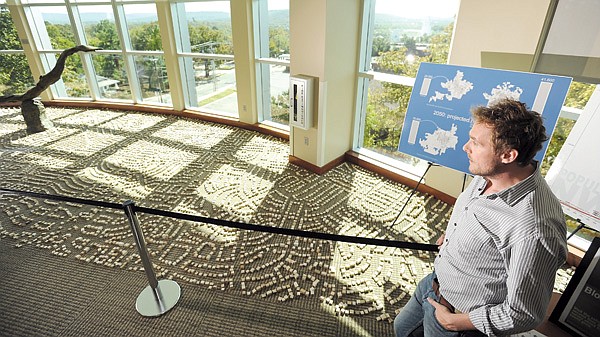FAYETTEVILLE — To illustrate the type of growth area residents can expect over 40 years, Carl Smith created an exhibit using 25,000 tiny, wooden blocks.
The University of Arkansas assistant landscape professor said most who’ve seen the exhibit have mixed emotions about the expected population increase.
“From my own research, when I was living in the United Kingdom, I found that more compact and dense design isn’t always seen in a good way by the general public,” he said. “I wondered if the same would be true in Northwest Arkansas. Since building this exhibit, I’ve come to understand that the general public in America is slightly conflicted in the way they feel about increased density.”
The population in Northwest Arkansas is expected to reach one million by 2050, with the four major cities either doubling or tripling in size, according to “Visioning Rail Transit in Northwest Arkansas,” a study done by the University of Arkansas Community Design Center.
Smith’s exhibit, “Blockbuster: Imagining a Future Fabric for Northwest Arkansas,” illustrates how the region could look after about 40 years of continued growth. The project has been on display at the Fayetteville Public Library for the past few weeks. Smith was on-hand Saturday at the library to answer questions from the public and provide information about his project.
“I think visualization is a big part of it,” said Karen Minkel, strategic consulting director for Fayetteville. “It allows you to see what good density and bad density look like. When you can make a connection between the two, it’s a huge benefit.”
Smith, who works for the university’s Fay Jones School of Architecture, used Bentonville as his model. The city is expected to increase by 25,000 new homes over the next several decades, which is the smallest expected growth in the region. Fayetteville, he said, could expect to see another 37,500 new homes during that time frame, while Springdale may see an additional 41,000 homes.
Fayetteville resident Joe Whitley said Fayetteville’s small-town feel was what attracted him to the area. The Huntsville native said he fears adding another 30,000 homes to the area could take away from the city’s charm.
“The city is already so behind on everything else; I don’t know how it could accommodate that much growth,” he said. “I hate seeing all these new apartment complexes everywhere, but I also don’t think they can do enough construction to keep up with the expected density.”
Smith’s exhibit, which was previously on display at the Sugar Gallery in Bentonville, features 25,000 houses represented by wood blocks, each about 1-inch-long and a half-inch in depth and height. The tiny blocks stand for roughly 2,000-square-foot houses arranged at a density of about 10 homes-per-acre.
“Seeing a set of figures that describes the population of Northwest Arkansas isn’t enough to illustrate the impact,” he said. “My own perception of the region, and what attracted me to live here, was the countryside and the scenery. On the other hand, I felt that Fayetteville had great potential in terms of becoming a vital city to live in. The increasing population sets some challenges to accommodate those people while protecting the countryside.”
Smith created the original exhibit with Bethany Springer, an assistant professor in the J. William Fulbright College of Arts and Sciences at the university. In addition to serving as public demonstration, he hopes to use the project as a means for collecting data for further research. Those who visit the exhibit are being asked to complete a questionnaire to share their thoughts about open spaces and lot sizes.
“I haven’t looked at the responses yet, but based on my previous research, I pretty much know what to expect,” he said. “It’s a pretty crude model and it can only tell us about typology of buildings that are low-rise, largely detached homes.
My goal is to move the state of the knowledge about what people in this region want so the city planning staff and developers can try to understand the challenges and opportunities of putting together a plan for more compact development.”
Smith will be at the Fayetteville Public Library again Oct. 30 to answer questions and share information.
***
Web Watch
For more information visit, www.faylib.org or call 479-856-7000.

